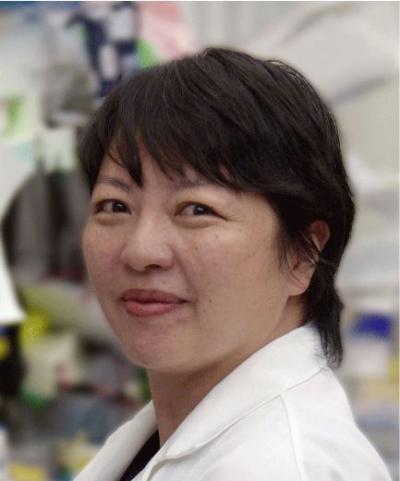HOSPITAL FOR SPECIAL SURGERY
(New York City. March 20, 2020.) A study by investigators at Hospital for Special Surgery (HSS) has discovered a molecule in the lymphatic system that has the potential to play a role in autoimmune disease. The study, “Lymph node stromal CCL2 limits antibody responses,” was published online today in the journal Science Immunology.

Lead investigator Theresa Lu, MD, PhD, senior scientist in the Autoimmunity and Inflammation Program at the HSS Research Institute, and colleagues launched the study to gain a better understanding of how the immune system works.
A healthy immune system defends the body against diseases and infection. When someone has an autoimmune disease, the immune system malfunctions and the body mistakenly attacks healthy cells, tissues and organs. Rheumatoid arthritis, lupus and scleroderma are examples of autoimmune diseases. If scientists can elucidate the underlying mechanism that causes autoimmune and inflammatory conditions, they can develop ways to correct the immune system flaws that lead to disease.
Dr. Lu’s study focused on the lymphoid tissues, which house immune cells and are sites of immune cell activation. Lymphoid tissues, which include the tonsils, spleen and lymph nodes, contain structural elements, such as fibroblasts and blood vessels. These structural elements were thought to mainly provide an infrastructure for the immune cells, but recent advances in the field have shown that they actively shape immune cell responses, and multiple populations of fibroblasts have different functions, according to Dr. Lu.
“We found that one fibroblast population expressed a molecule called CCL2 in the area of antibody-secreting immune cells, called plasma cells. We focused on the CCL2-expressing fibroblasts to see if they regulate plasma cell function,” she explained. “We found that CCL2 limits the magnitude of plasma cell responses by acting on an intermediary cell to reduce plasma cell survival. This was surprising in some ways, as CCL2 can also promote inflammation, and yet we are finding a role in limiting immune responses. This underscores the multiple functions that any molecule can have in different contexts.”
The findings have implications for better understanding autoimmune diseases, according to Dr Lu. Plasma cells in autoimmune diseases generate autoantibodies that then deposit and cause inflammation in organs such as the kidneys and skin. “By understanding that plasma cells can be controlled by this subset of fibroblasts, we can study these fibroblasts to see if they are perhaps not working properly in autoimmune and inflammatory diseases. We can then search for a way correct the malfunction, so they are less likely to cause disease,” she notes.
“As the immune system is so central to how well our bodies function and often acts in similar ways in a number of different settings, what we are learning about manipulating fibroblasts can also help the biomedical community better understand how to treat related processes, such as healing after a musculoskeletal injury, fighting cancer and fighting infections,” she adds. “For example, medications used in adults and children with different forms of autoimmune inflammatory arthritis or lupus are being examined in the setting of coronavirus infections. We all learn from each other.”
Dr. Lu’s lab and colleagues have been studying the vasculature and fibroblasts of lymph nodes for 16 years. Dragos Dasoveanu, PhD, was the first author of the current study. He conducted the research at HSS with Will Shipman, PhD; Susan Chyou, BA; and Varsha Kumar, PhD. In addition, scientists at research centers in New York, Switzerland and Australia collaborated on the study.
About HSS | Hospital for Special Surgery
HSS is the world’s leading academic medical center focused on musculoskeletal health. At its core is Hospital for Special Surgery, nationally ranked No. 1 in orthopedics (for the tenth consecutive year), No. 3 in rheumatology by U.S. News & World Report (2019-2020), and named a leader in pediatric orthopedics by U.S. News & World Report “Best Children’s Hospitals” list (2019-2020). Founded in 1863, the Hospital has one of the lowest infection rates in the country and was the first in New York State to receive Magnet Recognition for Excellence in Nursing Service from the American Nurses Credentialing Center four consecutive times. The global standard total knee replacement was developed at HSS in 1969. An affiliate of Weill Cornell Medical College, HSS has a main campus in New York City and facilities in New Jersey, Connecticut and in the Long Island and Westchester County regions of New York State. In addition, HSS will be opening a new facility in Florida in early 2020. In 2018, HSS provided care to 139,000 patients and performed more than 32,000 surgical procedures, and people from all 50 U.S. states and 80 countries travelled to receive care at HSS. There were more than 37,000 pediatric visits to the HSS Lerner Children’s Pavilion for treatment by a team of interdisciplinary experts. In addition to patient care, HSS leads the field in research, innovation and education. The HSS Research Institute comprises 20 laboratories and 300 staff members focused on leading the advancement of musculoskeletal health through prevention of degeneration, tissue repair and tissue regeneration. The HSS Global Innovation Institute was formed in 2016 to realize the potential of new drugs, therapeutics and devices. The HSS Education Institute is the world’s leading provider of education on musculoskeletal health, with its online learning platform offering more than 600 courses to more than 21,000 medical professional members worldwide. Through HSS Global Ventures, the institution is collaborating with medical centers and other organizations to advance the quality and value of musculoskeletal care and to make world-class HSS care more widely accessible nationally and internationally. www.hss.edu.

Leave a Reply